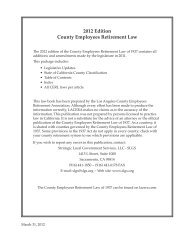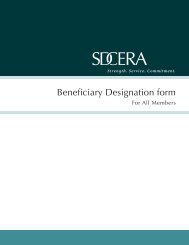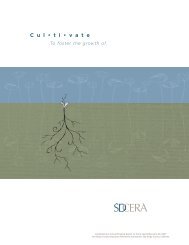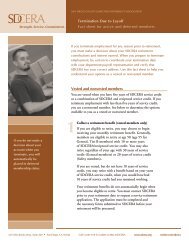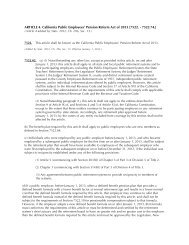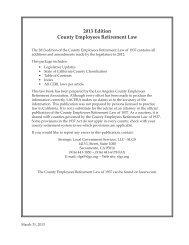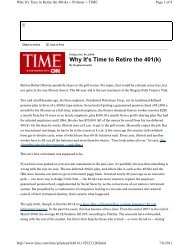Dividing Community Property booklet - sdcera
Dividing Community Property booklet - sdcera
Dividing Community Property booklet - sdcera
Create successful ePaper yourself
Turn your PDF publications into a flip-book with our unique Google optimized e-Paper software.
METHODS OF DIVIDING COMMUNITY<br />
PROPERTY<br />
If an active or deferred member’s SDCERA benefit must be divided, as determined by the<br />
court or by agreement of the parties, one of two methods of dividing community property<br />
must be selected.<br />
For retired members who are receiving a benefit, one method of dividing community property<br />
is available.<br />
METHODS AVAILABLE TO ACTIVE AND DEFERRED MEMBERS<br />
The two community property division methods available to active members are described<br />
below. It is the sole responsibility of the parties and their respective counsel to determine<br />
which method is most desirable based upon the parties’ obligations and needs.<br />
Separate account<br />
(Division and segregation of member’s accumulated contributions and service credit)<br />
With this method, community property interest in a member’s account is divided immediately,<br />
per court order, upon legal separation or dissolution of marriage. The member’s retirement<br />
service credit and accumulated employee contributions accrued during the marriage are<br />
divided into two separate accounts – one in the name of the member and one in the name of<br />
the nonmember.<br />
If the member was vested on the date of legal separation or marital dissolution, and when<br />
either the member or nonmember meets the minimum age and eligibility requirement for a<br />
service retirement, the nonmember has the right to apply for and receive a monthly retirement<br />
benefit independent of the member. The monthly benefit payable to the nonmember would be<br />
based on the service credited to his/her separate account, the nonmember’s age at retirement<br />
and the highest final compensation earned by the member. If the member retires before the<br />
nonmember, the final compensation used in calculating the nonmember’s retirement benefit is<br />
frozen.<br />
If the member was not vested on the date of legal separation or marital dissolution, the only<br />
option available to a nonmember is to receive a refund of his/her community property interest<br />
in the accumulated contributions. If the nonmember takes a refund of contributions and<br />
interest, the member would have the option of redepositing those contributions plus interest to<br />
restore the service credit and contributions to the member’s account. The nonmember also has<br />
this option if the member withdraws the accumulated contributions plus interest from his/her<br />
member account.<br />
Once the vested member’s account has been divided, the nonmember may submit his/her<br />
written retirement application to SDCERA if the following conditions are met:<br />
• Either the member or nonmember has met the minimum age requirement determined<br />
by the applicable service retirement formula of the member, and<br />
• On the date of retirement, the member had sufficient credited service to qualify for a<br />
service retirement, notwithstanding any service credit awarded to the nonmember.<br />
The nonmember’s monthly retirement benefit is calculated using the member’s final<br />
compensation on the date of the nonmember’s retirement, not on the date of separation.<br />
}<br />
4



